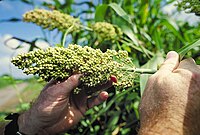
Photo from wikipedia
Understanding the mechanism for heat tolerance is important for the hot pepper breeding program to develop heat-tolerant cultivars in changing climate. This study was conducted to investigate physiological and biochemical… Click to show full abstract
Understanding the mechanism for heat tolerance is important for the hot pepper breeding program to develop heat-tolerant cultivars in changing climate. This study was conducted to investigate physiological and biochemical parameters related to heat tolerance and to determine leaf heat damage levels critical for selecting heat-tolerant genotypes. Seedlings of two commercial cultivars, heat-tolerant ‘NW Bigarim’ (NB) and susceptible ‘Chyung Yang’ (CY), were grown in 42 °C for ten days. Photosynthesis, electrolyte conductivity, proline content were measured among seedlings during heat treatment. Photosynthetic rate was significantly reduced in ‘CY’ but not in ‘NB’ seedlings in 42 °C. Stomatal conductivity and transpiration rate was significantly higher in ‘NB’ than ‘CY’. Proline content was also significantly higher in ‘NB’. After heat treatment, leaf heat damages were determined as 0, 25, 50 and 75% and plants with different leaf heat damages were moved to a glasshouse (30–32/22–24 °C in day/night). The growth and developmental parameters were investigated until 70 days. ‘NB’ was significantly affected by leaf heat damages only in fruit yield while ‘CY’ was in fruit set, number and yield. ‘NB’ showed fast recovery after heat stress compared to ‘CY’. These results suggest that constant photosynthetic rate via increased transpiration rate as well as high proline content in heat stress condition confer faster recovery from heat damage of heat-tolerant cultivars in seedlings stages.
Journal Title: Scientific Reports
Year Published: 2021
Link to full text (if available)
Share on Social Media: Sign Up to like & get
recommendations!